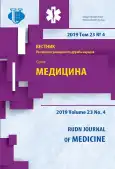Демографическая характеристика Московской области в начале XXI века
- Авторы: Оленин Я.А.1, Лебедева И.В.1
-
Учреждения:
- Московский государственный медико-стоматологический университет им. А.И. Евдокимова
- Выпуск: Том 23, № 4 (2019)
- Страницы: 418-430
- Раздел: ОРГАНИЗАЦИЯ ЗДРАВООХРАНЕНИЯ И ОБЩЕСТВЕННОЕ ЗДОРОВЬЕ
- URL: https://journal-vniispk.ru/2313-0245/article/view/345232
- DOI: https://doi.org/10.22363/2313-0245-2019-23-4-418-430
- ID: 345232
Цитировать
Полный текст
Аннотация
На социально-экономическое развитие страны и любого региона влияет множество факторов, среди которых важнейшая роль принадлежит демографическим, в обобщенном виде представляющим собой демографическую ситуацию. Под демографической ситуацией обычно понимают демографическую обстановку, состояние демографических процессов, состава и размещения населения в определенное время в стране или отдельном регионе. Таким образом, анализ демографической ситуации необходим для понимания основных параметров народонаселения, тенденций их динамики, прогнозирования численности, демографической структуры, демографического поведения населения. Цель: провести сравнительный анализ официальных статистических данных по демографическим процессам (статики и динамики населения) в Московской области (МО) за 2000-2015 гг. Материалы и методы: на первом этапе проведен сбор и анализ информационно-статистических источников, направлены запросы в Федеральную и территориальную службы государственной статистики Российской Федерации (Росстат, Мособстат, МИАЦ МО). На втором этапе проведена выкопировка данных по демографическим процессам в Московской области из полученных ответов Росстата, Мособстата, МИАЦа МО и с сайтов соответствующих организаций. Математико-статистический анализ включал вычисление средней арифметической простой, процентное соотношение величин, экономико-демографическую нагрузку на трудоспособное население, демографические коэффициенты и степень экономичности роста населения. Результаты и выводы. Численность населения Московской области в начале XXI века продолжает увеличиваться, но в основном за счет мигрантов, прибывающих из соседних регионов страны и зарубежья. Мужчин в регионе проживает 46,2%, а женщин 53,8% (2015). Мальчиков рождается больше, чем девочек, на 6%, и это преимущество сохраняется до 30-летнего возраста. А начиная с 35 лет количество женщин начинает преобладать над количеством мужчин на 3,5%. Данная тенденция сохраняется до 75 лет и старше. Возрастные группы населения области формируются по регрессивному типу: дети - 15,9%; трудоспособное население - 59,8%, а лиц старше трудоспособного возраста - 24,3% (2015). Экономико-демографическая нагрузка детьми и пожилыми на трудоспособное население составляет более 40%. Коэффициент рождаемости в регионе с 2000 по 2015 годы повысился на 76,7% и стал выше уровня 1990 года. Анализ суммарного коэффициента рождаемости свидетельствует о том, что в Московской области сохраняется мононуклеарный тип семьи (1-2-детная семья), т.е. нет расширенного воспроизводства населения. У детей и в трудоспособном возрасте коэффициент смертности у мужчин выше, чем у женщин. У мужчин смертность в трудоспособном возрасте доходит до 41% от общей смертности. Количество женщин, умерших в трудоспособном возрасте, в 4 раза меньше, чем мужчин. Естественный прирост населения Московской области за 15 лет XXI века имеет небольшое, но отрицательное значение, так как население убывает, а увеличение численности населения идет преимущественно за счет высокой миграции.
Ключевые слова
Об авторах
Я. А. Оленин
Московский государственный медико-стоматологический университет им. А.И. Евдокимова
Автор, ответственный за переписку.
Email: jarosol@mail.ru
Москва, Российская Федерация
И. В. Лебедева
Московский государственный медико-стоматологический университет им. А.И. Евдокимова
Email: jarosol@mail.ru
Москва, Российская Федерация
Список литературы
- Schepin OP, Medic VA. Health of the region’s population and health priorities. Moscow:Geotar-Media; 2010. 384 p. (In Russ.)
- Malkhazova SM, Semenova VYu, Shartova NV, Gurov AN. Health of the population of the Moscow region. Medical and geographical aspects. Moscow: GEOS; 2010. 110 p. (In Russ.)
- Official website of the Federal state statistics service. Available from: http://www.gks.ru (In Russ.)
- Demographic Yearbook of Russia. 2000. Statistical handbook. Moscow: Rosstat; 2001. 242p. (In Russ.)
- Demographic Yearbook of Russia. 2010. Statistical handbook. Moscow: Rosstat; 2011. 557p. (In Russ.)
- Demographic Yearbook of Russia. 2015. Statistical handbook. Moscow: Rosstat; 2016. 321p. (In Russ.)
- Medical and demographic indicators of the Russian Federation in 2016. Statistical handbook. Moscow: Ministry of health of Russia; 2017. 254p. (In Russ.)
- Medik VA, Tokmachev MS. Guide to Health and Health Statistics. Moscow: Medicine; 2006. 528p. (In Russ.)
- Kolesnikov BL. The state of health and demographic processes in the Orenburg region at the beginning of the XXI century. Ed. Lebedeva IV. Moscow: Medicine; 2007. 168p. (In Russ.)
- Lebedev AA, Lebedeva IV, Zhusjanov OT. Basis for the development of society — investment in human health. Alma-Ata; 1986. 233p. (In Russ.)
- Volkov VV. State of health of the population and demographic processes of municipal industrial formation of the subject of the Russian Federation: on the example of municipal formation-Togliatti. Orenburg; 2013. 51p. (In Russ.)
- Kurman MV. Actual issues of demography. Moscow: Statistics; 1976. 220p. (In Russ.)
- Milovidov AS. Years of life and years of work. Moscow: Finance and statistics; 1983. 117p.
- WHO. World statistics. Report “Life expectancy and Healthy life expectancy”. Country data. 2016. Available from: https://apps.who.int/gho/data/node.main.688
- Coleman D. Immigration and Ethnic Change in Low-fertility Countries: A Third Demographic Transition. (Statistical data.) Population and Development Rev. 2006 Sept; 32(3): 401—46. Available from: https://doi.org/ 10.1111/j.1728-4457.2006.00131.x
- Easterlin R. The Birt Dearth, Aging, and the Economy. In: Asefa S, Huang WCh, editors. Human Capital and Economic Development. Kalamazoo: MI: W. E. Upjohn Inst. for Employment Research; 1994. p.11—35. Available from: https://research.upjohn.org/cgi/viewcontent.cgi? article=1198&context=up_press
- Lanzieri G. Is Fertility Converging across the Member States of the European Union? Eurostat, Work Session on Demographic Projections. Lisbon; 2010. 137p.
Дополнительные файлы









